There are only ten different snakes found in Montana.
And we have good news: only one of them is poisonous – the Prairie Rattlesnake, aka the rattlesnake. For a state known for its wildlife, this is a bit surprising, right?
You can usually find rattlesnakes basking in the sun on a sandstone rock during cooler summer months or in shaded areas on hot days, and it’s critical to steer clear of them at all costs.
However, the other nine snakes found in Montana are mostly harmless (though their bright colors may startle you!).
Here’s everything you need to know about Montana’s snakes, plus a list of the 10 types of snakes found in Montana.
In this article:
- Are there a lot of snakes in Montana?
- What is Montana’s most common snake?
- Are there any poisonous snakes in Montana?
- What to do if you get bit by a rattlesnake
- Are there deadly snakes in Montana?
- 10 snakes found in Montana
Are there a lot of snakes in Montana?
Montana is home to only ten snake species, including the Garter Snake, Northern Rubber Boa, and the Prairie Rattlesnake. It’s common to see snakes in Montana, especially during the summer, but Montana does not have an exceptionally large snake population.
What is Montana’s most common snake?
The most common snake in Montana is the Garter Snake, of which there are three species in Montana – Common Garter Snake, Western Terrestrial, and Plains Garter Snake. People in Montana often see Garter Snakes in backyards and near water.
Are there any poisonous snakes in Montana?
Of Montana’s ten snake species, the only one that is poisonous is the Prairie Rattlesnake. A rattlesnake bite causes redness, swelling, and blistering around the bite as well as nausea, vomiting, dizziness, and labored breathing. Rattlesnake bites can be fatal if left untreated.
What to do if you get bit by a Rattlesnake?
If you get bit by a rattlesnake in Montana, get to a hospital as soon as possible. In the meantime:
DO:
- Firstly, don’t panic – rattlesnake bites are rarely fatal
- Call an ambulance (if possible, ride your bike or walk to a friend’s car to drive to the nearest hospital)
- If you’re out of cell service and you can walk or ride your bike, get to an area with cell service and call 911
- Sit down and rest
- Keep the wounded limb below heart level
- Remove watches or other items that will restrict swelling
It’s equally important to know what NOT to do if you are bitten by a rattlesnake.
DO NOT:
- Make an incision to suck out the venom – this tactic from Western movies unfortunately doesn’t help
- Use a snakebite kit – common kits usually include a blade for making an incision, which often does more damage to your limb than benefit. They may also contain a suction device, which is ineffective at removing the venom
- Apply a tourniquet – tourniquets cut off blood flow and oxygen to tissues, often leading to permanent damage or tissue death
- Apply ice – This doesn’t help treat the bite and can cause frostbite
- Consume caffeine, alcohol, or any medication
- Apply electric shock – This is a dangerous practice that can alter the venom’s natural composition, and damage proteins in your body
To keep your lower legs protected from snakebites, shin gaiters will do the trick if you pair them with above-ankle shoes:
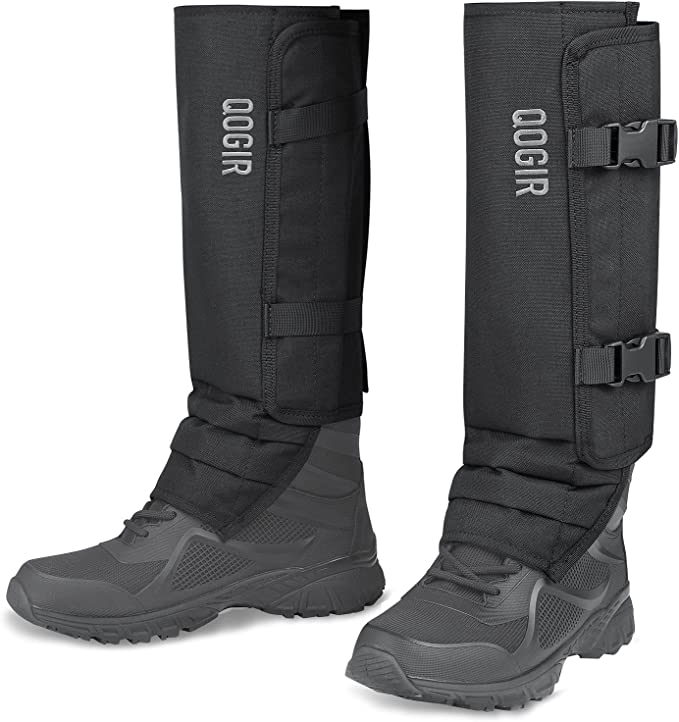
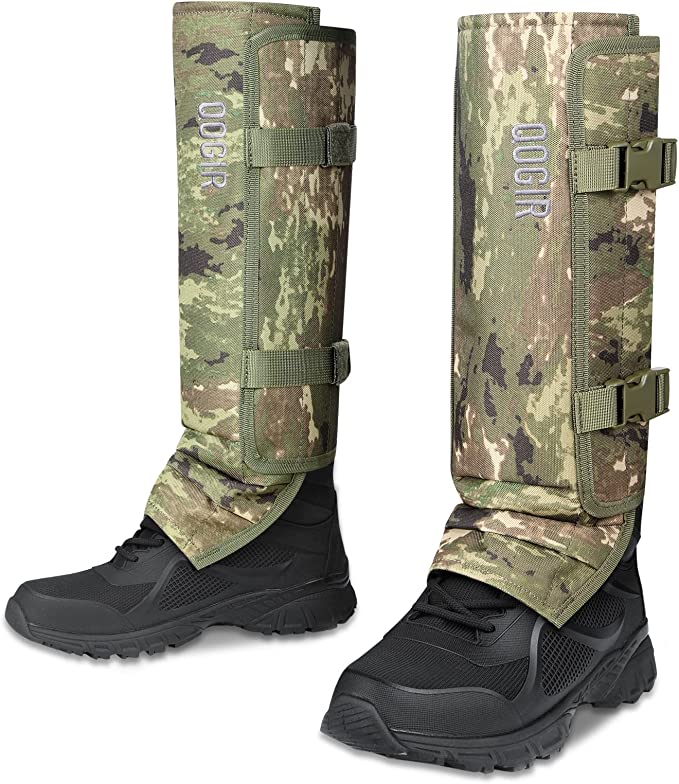
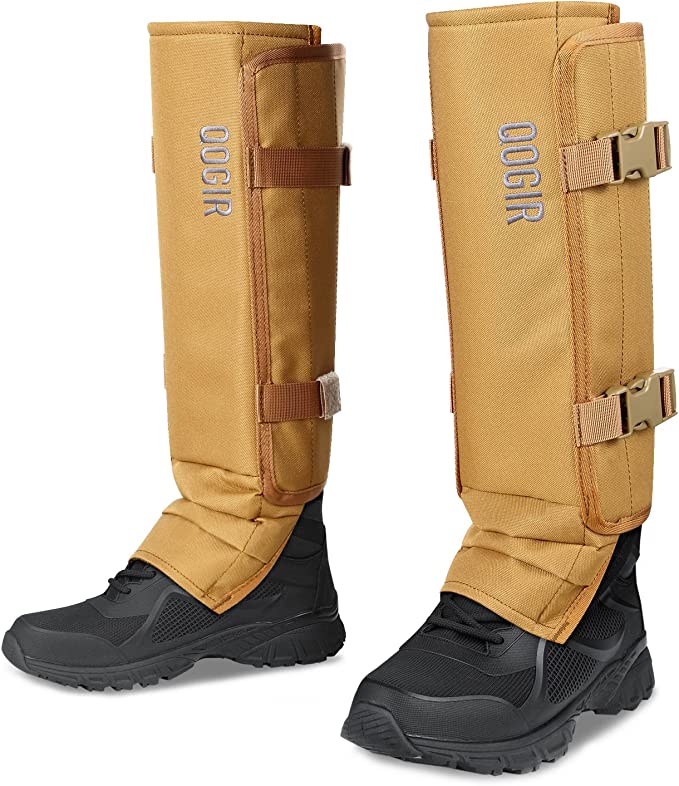
They look bulky, but they’re actually very lightweight and also protect from thorns, cactus needles, and other dangers you come across walking in the woods or desert.
Are there deadly snakes in Montana?
The Prairie Rattlesnake is Montana’s only deadly snake. Usually, rattlesnake bites aren’t fatal, but they can be if left untreated.
What is the giant snake in Montana?
Montana’s largest snake is the Bullsnake, or Gopher Snake. Adult Bullsnakes range from 3 to 5 ft (1 to 1.5 m), with some growing to 7 ft (2.1 m).
So, what types of snakes are found in Montana? Without further ado, here is a list of all 10 snakes found in Montana.
10 Snakes found in Montana
1. Prairie Rattlesnake – The only poisonous snake in Montana
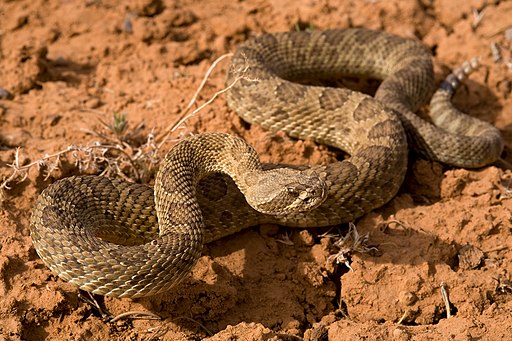
Venom rating: High
Threat to humans: High (untreated bites can be fatal)
Markers:
- Warning rattle
- Triangular head
- Blunt nose
- Slim neck
- Stout body
- Pale green or brown
- Brown or black blotches
Habitat:
- Grasslands
- Prairies
- Forests
- Brush
- Caves
- Rock ledges
- Along streams
Regions of Montana: Statewide, except for the northwest corner
Size: 1 – 5 ft (30 – 150 cm) long
Diet: Prairie dogs, ground squirrels, rabbits, mice, rats, and sometimes other snakes
Interesting facts:
- It avoids desert areas
- It’s the only venomous snake in Montana
What are the most dangerous animals in Montana? Find out
2. Garter Snake – Snakes in Montana
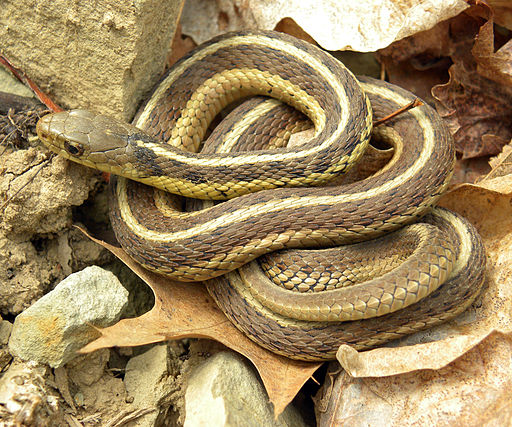
Venom rating: Low
Threat to humans: Low (Its bite can cause minor swelling. Keep small children away. Bite wounds should be cleaned immediately)
Markers:
- Medium-sized
- Three yellow stripes (one down the back, two down each side)
- Dark olive stripes between the yellow stripes, or black stripes between the yellow stripes broken by red dots
- Pale yellow or bluish-gray underside
Habitat: All habitats, but mostly in low elevations around water
Regions of Montana: Statewide, except for a small area in the northeast
Size: Up to 3 ft (1 m) long
Diet: Toads, chorus frogs, fish remains, and earthworms
Interesting facts:
- It hibernates in dens in groups of hundreds (One den in Canada contained more than 8,000 hibernating Garter Snakes)
What did the Blackfoot tribe of Montana eat? Find out
3. Northern Rubber Boa – Snakes in Montana
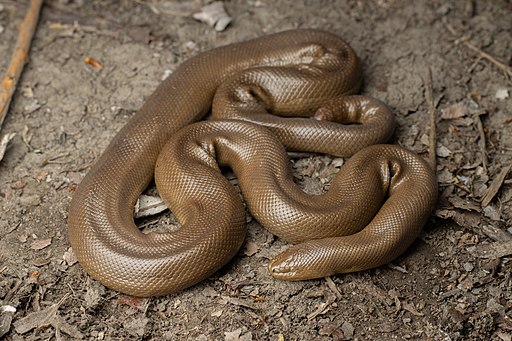
Venom rating: Non-venomous
Threat to humans: Low
Markers:
- Looks and feels like rubber
- Small, shiny
- Very small eyes
- Blunt tail
- Small, smooth scales
Habitat:
- Moist or dry forest areas
- Under logs and rocks
Regions of Montana: South-central, southwest, west, and northwest regions
Size: 15 – 33 in (38 – 84 cm)
Diet: Mice, lizards, lizard eggs, small birds, snakes
Interesting facts:
- Slow moving
- Nocturnal
- Looks and feels like rubber
Who are the Amish of Montana? Find out
4. Hog-nosed Snake – Snakes in Montana
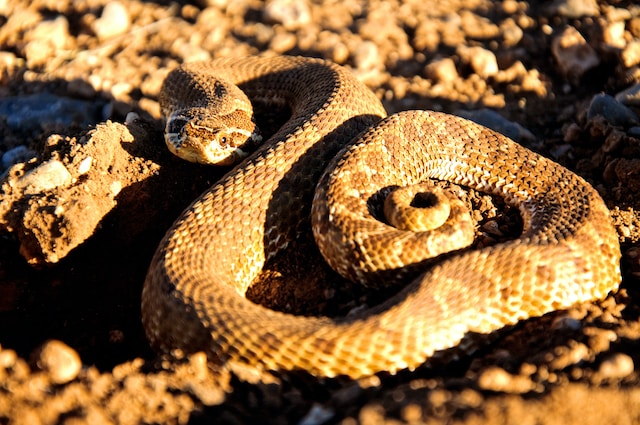
Venom rating: Low
Threat to humans: Low
Markers:
- Upturned nose
- Dark spots on olive background (their colors vary widely, depending on their environment)
Habitat: Prairie, dry riverbeds, brushlands
Regions of Montana: East of the Rocky Mountains
Size: Up to 3 ft (1 m)
Diet: Tree frogs, toads, small lizards, birds, and small rodents
Interesting facts:
- Because of its dark spots, people sometimes mistake it for a rattlesnake, but it is easily identified by its upturned nose
- It plays dead when other attempts to intimidate predators don’t work
- It often attempts to mimic a cobra by widening itself and hissing
- Its saliva is venomous, but it doesn’t have injectable venom
Which Hollywood blockbusters were filmed in Montana? Find out
5. Western Terrestrial Garter Snake – Snakes in Montana
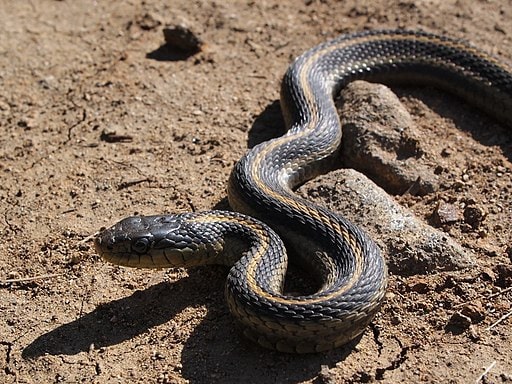
Venom rating: Low
Threat level to humans: Low (Its bite can cause minor swelling. Keep small children away. Bite wounds should be cleaned immediately)
Markers:
- Three yellow stripes (one down the center and two lateral) running the length of the body
- Black spots between the stripes or overlapping the stripes
- Brown or greenish color between the stripes (occasionally they are all-black)
Habitat: Deserts, plains, mountains, meadows, forests, near water, around lakes and streams
Regions of Montana: Statewide, except for a small area in the northeast
Size: Up to 3.5 ft (1.09 m)
Diet: slugs, snails, worms, leeches, frogs, tadpoles, fish, mice, and small birds
Interesting facts:
- It has a strong sense of vision and smell
- It has nostrils for breathing, but it flicks its tongue to pick up scents
Wyoming vs Montana – What’s the difference? Find out
6. Plains Garter Snake – Snakes in Montana
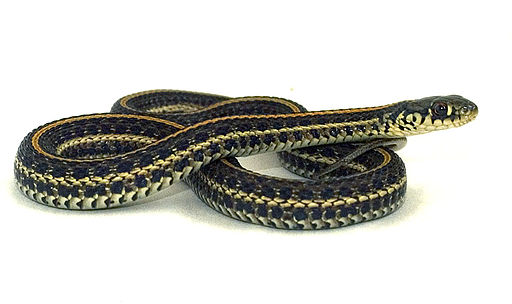
Venom rating: Low
Threat level to humans: Low (Its bite can cause minor swelling. Keep small children away. Bite wounds should be cleaned immediately)
Markers:
- Three yellow stripes (one down the center and two lateral) running the length of the body
- Black spots between the stripes or overlapping the stripes
- Brown, greenish, or olive background color between the stripes (occasionally they are all-black)
- They look similar to the other Garter Snakes on this list
Habitat: meadows, marshes, wet prairies, lakes, and ponds
Regions of Montana: Central and eastern regions, east of the Rocky Mountains
Size: 15 – 28 in (38 – 71 cm)
Diet: Worms, insects, frogs, fish, rodents, and eggs
Interesting facts:
- It has live births
- It can swim and climb trees!
7. Milk Snake (Kingsnake) – Snakes in Montana

Venom rating: Low
Threat level to humans: Low
Markers:
- Distinct red and white horizontal stripes or blotches, with thinner black stripes in between
- White or yellow underside
- Rounded snout
Habitat: Farmland, meadows, disrupted areas, river bottoms, rocky hillsides, and forests
Regions of Montana: Eastern and central regions
Size: 16 – 28 in (41 – 71 cm)
Diet: Lizards, reptiles, birds, bird eggs, worms, insects, and other snakes
Interesting facts:
- Milk Snakes are the most widespread snake in North America
- It resembles the poisonous coral snake of southeastern states
Did you know Montana has more cows than people? Discover 10 things Montana is known for
8. Bullsnake (Gopher Snake) – Snakes in Montana
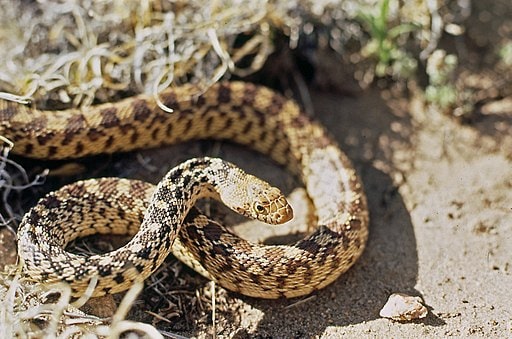
Venom rating: Low
Threat level to humans: Low
Markers:
- Black and brown blotched pattern running down the back and sides
Habitat: Prairie, sandy areas, forests, agricultural fields, and brush
Regions of Montana: Statewide
Size: 3 – 7 ft (1 – 2.1 m)
Diet: Rabbits, rodents, birds, and sometimes lizards
Interesting facts:
- It sometimes vibrates its tail when alarmed – when vibrating against sagebrush or other flora, it mimics the sound of a rattlesnake
- It sometimes climbs trees
Where are the best places to stargaze in Montana? Find out
9. Eastern Racer (Coluber constrictor) – Snakes in Montana
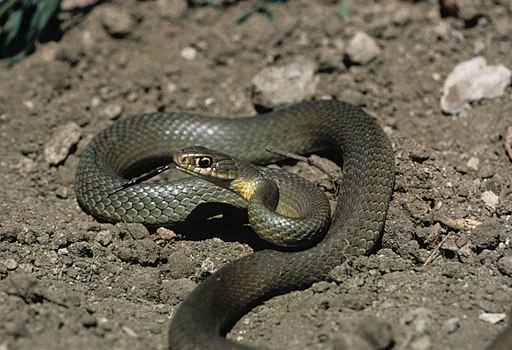
Venom rating: Low
Threat level to humans: Low (though they are known to bite when they feel threatened)
Markers:
- Glossy black, greenish grey, or blue
- White or yellow underside
- Relatively large eyes
- Smooth scales
Habitat: Forests and grasslands
Regions of Montana: Statewide, except for a small area in the northwest
Size: 20 – 65 in (51 – 165 cm)
Diet: Small mammals, lizards, orthopterans (grasshoppers, locusts, crickets), and frogs
Interesting facts:
- It can move over 4 mph (6.4 km/h)
- It raises its head off the ground as it looks for prey
What’s life really like where “Yellowstone” is filmed? Discover Darby, Montana
10. Smooth Green Snake – Snakes in Montana
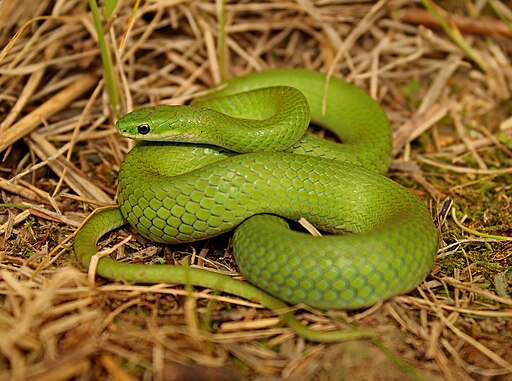
Venom rating: Non-venomous
Threat level to humans: Low
Markers:
- Bright green with smooth scales
- White or yellow underside
Habitat: Grassy marshes, moist fields at the forest edge, moist woodland, meadows, stream borders, mountain shrublands, and bogs
Regions of Montana: Far northeastern Montana
Size: Up to 26 in (66 cm)
Diet: Invertebrates such as grasshoppers, caterpillars, slugs, and earthworms
Interesting facts:
- It is rarely seen in Montana – only occasionally in wetlands of northeastern Montana
- It may be olive, gray, or brown at first, but after shedding its skin for the first time, it becomes bright green
FAQ – Snakes in Montana
Below are answers to more common questions about snakes in Montana.
When do snakes hibernate in Montana?
Montana’s snake species go into hibernation, or brumation (a period of lesser activity, but not as deep as hibernation), in the autumn, anytime from September to December.
When do snakes come out in Montana?
Snakes in Montana come out in late March, or early April, and remain active until they go into hibernation, or brumation (a period of lesser activity, but not as deep as hibernation) in the fall.
Are there water snakes in Montana?
There are no true water snake species in Montana; however, all three Garter Snake species as well as Bullsnakes and Smooth Green Snakes in Montana can swim.
What US state has the least snakes?
Alaska is the only U.S. state with no snake population.


